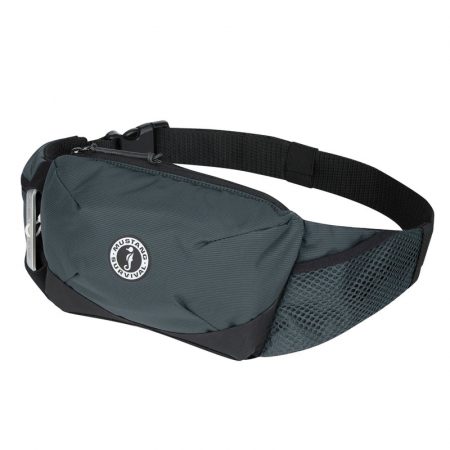
We tested 13 different life jackets head-to-head to find the best one for you based on your paddling experience and swimming abilities. Photo: Nick Bruckbauer//The Inertia
Want to stay safe and legal while stand up paddle boarding, but not sure where to start? We’re here to help! We tested 13 of the best life jackets for paddle boarding to help you find the right model for your paddling experience, swimming abilities, and budget.
Life jackets — also known as PFDs (personal flotation devices) — are a simple yet important addition to your paddle boarding kit, and may be legally required depending on where you paddle. Stand up paddle boarding (SUPing) has become one of the fastest-growing water sports over the last decade. And most of today’s best inflatable paddle boards include all the gear and accessories you’ll need to hit the water — except for a life jacket.
Our test lineup includes three different styles of life jackets: inflatable belts, inflatable vests, and foam vests. Each style has different pros and cons and might be more or less suitable for you depending on your age, swimming and paddling abilities, and paddling conditions. Read on for our top picks, and for more information on choosing a life jacket, check out our buyer’s guide.
Navigate To: Comparison Table | How We Tested | Buyer’s Guide
Related: Best Paddle Boards | Best Inflatable Paddle Boards | More Paddle Gear Reviews
The Best Life Jackets for Paddle Boarding
Inflatable Belt Style:
Best Inflatable Belt Life Jacket: Mustang Survival Essentialist Belt Pack
Best Value Inflatable Belt Life Jacket: BOTE Inflatable Belt PFD
Lightest Inflatable Belt Life Jacket: Onyx M-16 Inflatable Belt
Most Buoyant Inflatable Belt Life Jacket: NRS Zephyr Inflatable PFD
Inflatable Vest Style:
Best Inflatable Vest Life Jacket: NRS Otto Matik Inflatable Vest
Best Value Inflatable Vest Life Jacket: BOTE Inflatable Vest PFD
Foam Vest Style:
Best Foam Vest Life Jacket: NRS Ninja PFD
Best Hybrid Foam/Inflatable Vest: Mustang Survival Khimera Dual Flotation
Best Inflatable Belt Life Jacket for Paddle Boarding
Mustang Survival Essentialist Belt Pack ($150)
Life Jacket Style: Inflatable Belt
USCG Classification: Type V
Measured Weight: 13.8 oz.
Claimed Buoyancy: 18.9 lbs.
Sizes Available: One size (30″ to 52″ waist)
Pros: Comfortable waist belt, several pockets, metal pull tab, lightweight
Cons: Somewhat pricey for a belt-style device
The Mustang Survival Essentialist Belt Pack is our overall favorite life jacket for paddle boarding. This inflatable belt-style device is ideal for experienced paddlers and confident swimmers who don’t want to feel restricted by a vest-style life jacket. At a measured 13.8 ounces, it’s one of the lighter inflatable belts that we tested, yet it comes with some nice extra features like a comfortable waist strap, two zippered pockets, a mesh stuff pocket, and a metal pull tab.
Like all inflatable belt life jackets, the Essentialist must be worn at all times in order to meet Coast Guard regulations. It also must be manually inflated in order to provide flotation — either via a pull tab that activates a CO2 canister or with the oral inflation tube. This makes it less ideal for less confident swimmers and paddlers or for paddling in extreme water or weather conditions.
If you’re an experienced paddler looking for a lightweight belt pack and are willing to sacrifice a couple of ounces and a couple of extra bucks for some nice bonus features, the Mustang Survival Essentialist is the right life jacket for you.
CHECK PRICE ON REI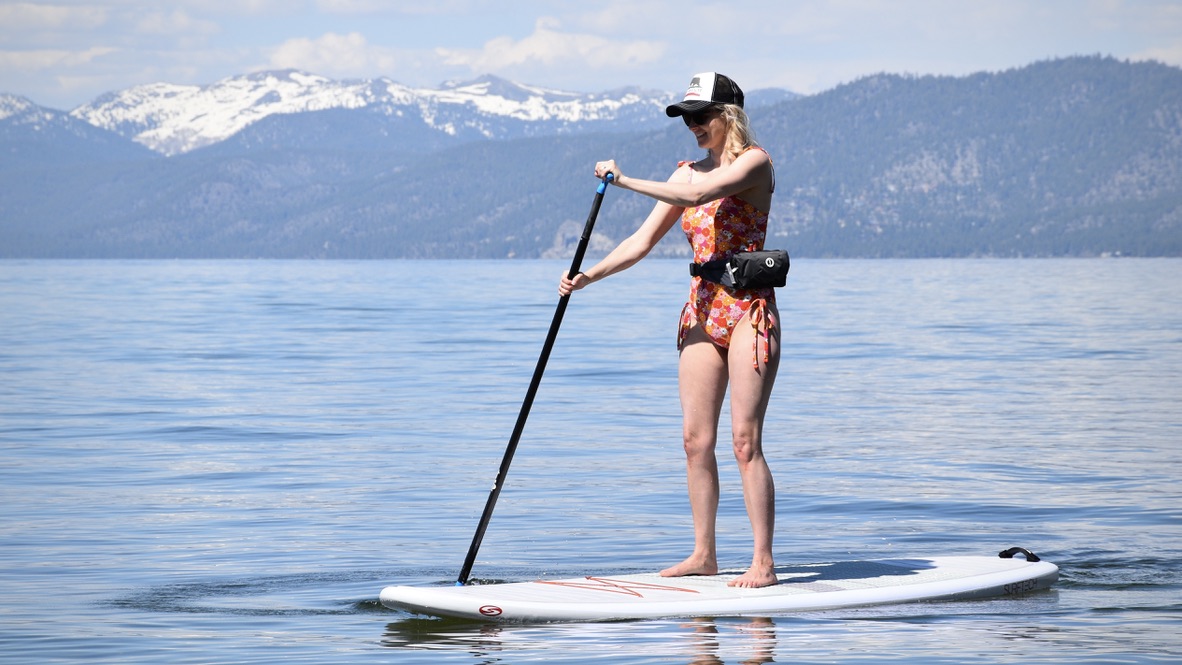
The Mustang Survival Essentialist is lightweight, comfortable, and helps you feel free and unrestricted while paddling. Photo: Nick Bruckbauer//The Inertia
Best Value Inflatable Belt Life Jacket for Paddle Boarding
BOTE Inflatable Belt PFD ($99)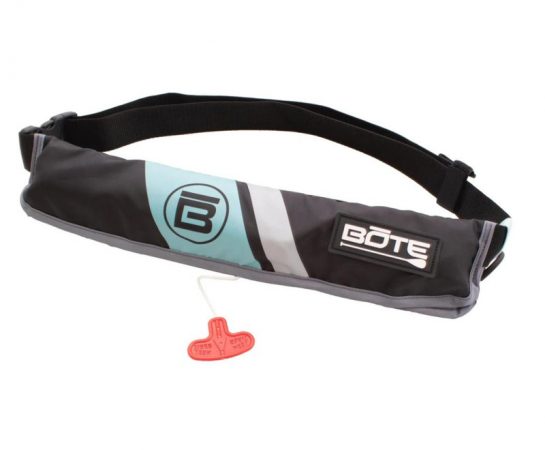
Life Jacket Style: Inflatable Belt
USCG Classification: Type V
Measured Weight: 13.6 oz.
Claimed Buoyancy: 22.5 lbs.
Sizes Available: One size (30″ to 52″ waist)
Pros: Reasonable price, fairly lightweight, comfortable material against the body
Cons: No additional pockets or extra features
The BOTE Inflatable Belt PFD is our recommendation for paddlers looking for an inflatable belt life jacket who also want to save a few bucks. With one of the least expensive list prices in our test lineup, the BOTE is nearly identical to the Astral Airbelt 2.0 but comes with a nearly $40 lower price tag. The BOTE does weigh about half an ounce more than the Airbelt, but still comes in at a respectable 13.6 ounces. Many inflatable life jackets share similar components with other brands and models since many of the inner workings are manufactured by third-party companies. The BOTE has a very similar inflation valve, flotation pouch, outer shell, and belt design as the Astral Airbelt.
Since inflatable belt life jackets are ideal for strong swimmers and paddlers who likely hope only to inflate the device in a rare emergency situation, the BOTE Inflatable Belt is a great option to stay safe and legal while saving some money.
CHECK PRICE ON BOTE
The BOTE Inflatable Belt PFD is the most affordable life jacket in our test and is very similar to more expensive options. Photo: Shannon Bruckbauer//The Inertia
Lightest Inflatable Belt Life Jacket for Paddle Boarding
Onyx M-16 Inflatable Belt ($120)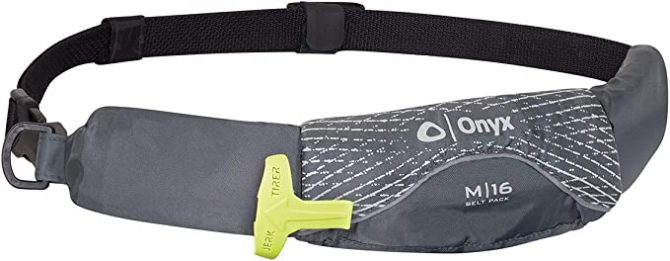
Life Jacket Style: Inflatable Belt
USCG Classification: Type V
Measured Weight: 11.4 oz.
Claimed Buoyancy: 22.5 lbs.
Sizes Available: One size (30″ to 52″ waist)
Pros: Lightest model we tested, reasonable price, pull tab mounts to the device rather than dangling
Cons: Narrow webbing on the waist belt, no extra pockets
If you’re looking to meet Coast Guard flotation device requirements with the lightest, least restrictive device we tested, the Onyx M-16 Inflatable Belt is the one for you. Weighing in at a mere 11.4 ounces, the M-16 is the lightest model in our lineup and still provides the same level of flotation as other heavier devices. It also has a reasonable price tag, coming in as the second least expensive model we tested, and can often be found on sale for less.
The M-16 is a very simple device. Compared to other inflatable belt devices, it sheds a few ounces by using narrower webbing material for the waist belt and by having a unique housing design for the flotation pouch. With no extra bells or whistles, the Onyx M-16 has a lightweight, minimalist design that will make you forget you’re wearing a life jacket at all.
CHECK PRICE ON AMAZON
The Onyx M-16 is the lightest life jacket we tested and is one of the most affordable, too. Photo: Shannon Bruckbauer//The Inertia
Most Buoyant Inflatable Belt Life Jacket
NRS Zephyr Inflatable PFD ($150)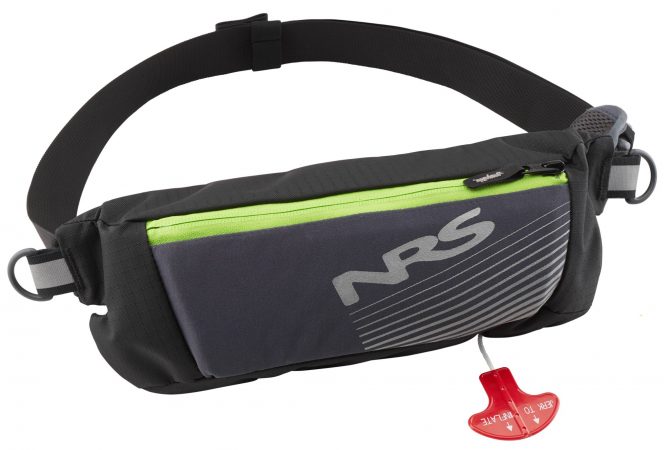
Life Jacket Style: Inflatable Belt
USCG Classification: Type V
Measured Weight: 20.0 oz.
Claimed Buoyancy: 27.8 lbs.
Sizes Available: One size (30″ to 52″ waist)
Pros: Inflates into a large vest-style life jacket and includes a huge storage pocket
Cons: Pricey and heavy for a belt-style device
The NRS Zephyr is a unique inflatable belt-style life jacket that provides the convenience of a belt-style device with the extra buoyancy provided by a full vest. Most other belt-style devices have a rectangular flotation pouch with a strap that slips over your head and provide approximately 16 to 22 pounds of buoyancy. The Zephyr inflates into a full vest-style life jacket that surrounds your neck and shoulders and provides nearly 28 pounds of buoyancy. This makes it an ideal choice for heavier paddlers or less confident swimmers who will appreciate the security of a little extra buoyancy.
As the Zephyr’s design and performance blur the lines between a belt and a vest, so too do its price and its weight. Both are on the upper end for a belt-style device but comfortably below most vest styles. It also has one of the largest zipper pockets of any model that we tested, a nice bonus feature.
CHECK PRICE ON REI
The NRS Zephyr combines the convenience of a wearable belt with the protection of a full-coverage vest. Photo: Shannon Bruckbauer//The Inertia
Best Inflatable Vest Life Jacket for Paddle Boarding
NRS Otto Matik Inflatable Vest ($215)
Life Jacket Style: Inflatable Vest
USCG Classification: Type V
Measured Weight: 23.0 oz.
Claimed Buoyancy: 22.5 lbs.
Sizes Available: One size (30″ to 52″ chest)
Pros: Automatically inflates when submerged in water, inflation chamber is fused to the outer shell (no folding or repacking required), includes a storage pocket
Cons: Expensive, no way to prevent inflation once submerged in water
The NRS Otto Matik is our favorite overall inflatable vest life jacket for one primary reason. Its inflation chamber is fused to the outer shell material, meaning that the entire jacket inflates and deflates as a singular unit, whereas every other inflatable model we tested has a separate internal inflation pouch that must be deflated, folded, and repacked before the next use. This makes the Otto Matik much simpler to use and inspires user confidence that the jacket is prepared to operate correctly.
While the Otto Matik will automatically inflate once submerged in water, it can also be manually inflated by pulling on the ripcord or by using the oral tube.
One notable downside is that there is no way to prevent the Otto Matik from inflating when it’s submerged in water. This could make it a good option if you’re a weak swimmer or if you’re paddling in extreme conditions where flotation is definitely necessary, but it makes it a poor choice if you’re a strong swimmer paddling in calm conditions, and you wouldn’t want it to inflate every time you hit the water. Keep in mind that it also must be re-armed with a new CO2 cartridge after every inflation.
Paddlers who appreciate the simple design of having the inflation chamber fused to the outer shell but don’t want or need the “always-on” automatic inflation capability should check out the NRS Matik life jacket. This has the same shell design but can only be inflated manually by pulling the ripcord or using the oral tube. This may be a better option for many paddlers, where falling off the board or taking a swim doesn’t always require instant flotation.
Check out the video below for a demonstration of the Otto Matik automatically inflating in the water.
CHECK PRICE ON REIBest Value Inflatable Vest Life Jacket for Paddle Boarding
BOTE Inflatable Vest PFD ($169)
Life Jacket Style: Inflatable Vest
USCG Classification: Type V
Measured Weight: 21.0 oz.
Claimed Buoyancy: 26.0 lbs.
Sizes Available: One size (30″ to 56″ chest)
Pros: Can be inflated manually or automatically, less expensive than other inflatable vests
Cons: No storage pockets or extra features
The BOTE Inflatable Vest PFD has the lowest list price of any inflatable vest that we tested and has the convenience of being able to convert between automatic and manual inflation. This vest comes standard with an automatic inflation mechanism that is triggered when it is submerged in water, but can be switched out for a manual inflation mechanism that will only be inflated when the ripcord is pulled. This gives users the convenience of adjusting the performance attributes of the life jacket depending on the paddler or the paddling conditions.
The BOTE is very similar in design and construction to the Onyx A/M-24 Inflatable Vest but lists for around $50 less, making it a great value. Both vests use many similar internal third-party components, like the inflation valve and the air pouch. An inflatable vest like this is a great option for paddlers who want some extra flotation compared to an inflatable belt device but still want less weight and bulk than a traditional foam life vest. Note that the BOTE Inflatable Vest, like all other inflatable life jackets, must be worn at all times in order to meet Coast Guard requirements.
CHECK PRICE ON BOTE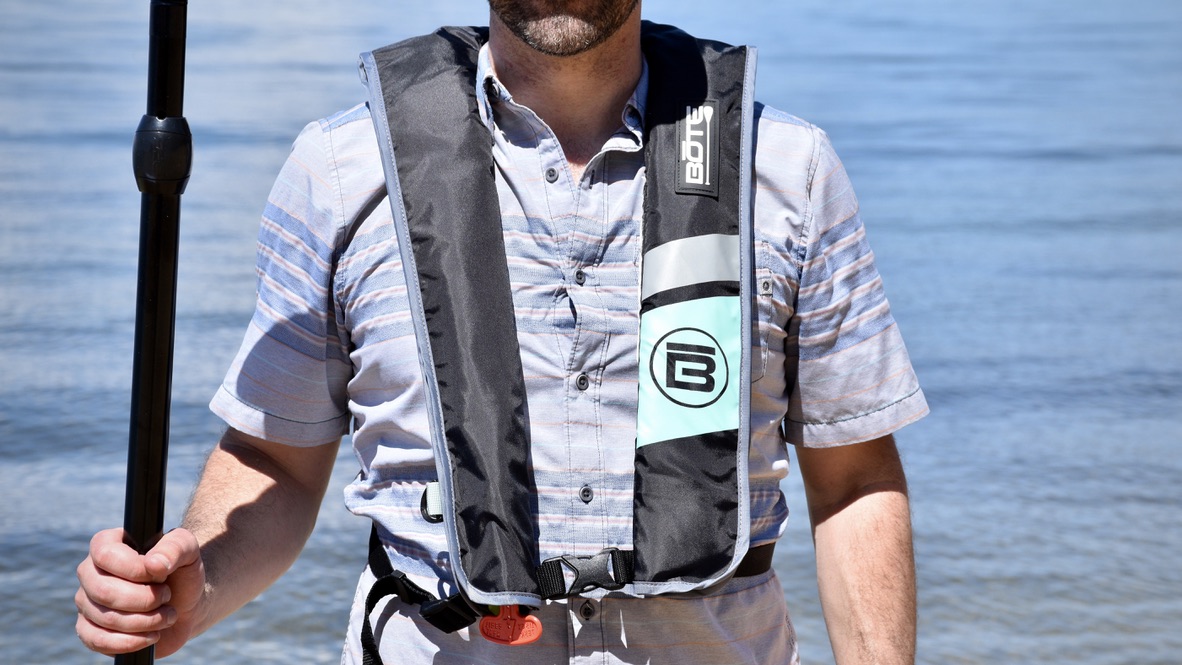
The BOTE Inflatable Vest PFD has many of the same features as similar vests that are more expensive. Photo: Shannon Bruckbauer//The Inertia
Best Foam Vest Life Jacket for Paddle Boarding
NRS Ninja PFD ($150)
Life Jacket Style: Foam Vest
USCG Classification: Type III
Measured Weight: 34.7 oz.
Claimed Buoyancy: 15.8 lbs.
Sizes Available: S/M (33″-40″ chest), L/XL (38″-46″ chest), XXL (42″-50″ chest)
Pros: Excellent paddling mobility, comes in several bright colors, includes storage pockets
Cons: Heavy, even for a foam vest
With a unique low-profile design that helps optimize paddling mobility, the NRS Ninja earns our pick as our favorite traditional foam life jacket for paddle boarding. The Ninja sits lower on the torso than most foam life vests and has the foam material concentrated in a smaller area, leaving larger cutouts for your arms and shoulders. And while all foam life jackets may have the tendency to ride up your chest during dynamic activities like paddle boarding, we found this to be minimal with the Ninja.
The main downside of the Ninja is that it is the heaviest life jacket we tested, even weighing around 10 ounces more than another foam life jacket, the Astral E-Ronny. We still slightly preferred the design of the Ninja over the E-Ronny because of its excellent mobility. The Ninja also has a convenient front clamshell pocket with internal organization and a hand-warming sleeve between two of the front foam panels.
CHECK PRICE ON REI
The NRS Ninja is our favorite foam life jacket for paddle boarding, thanks to its low-profile design that allows excellent mobility. Photo: Shannon Bruckbauer//The Inertia
Best Hybrid Foam/Inflatable Vest Life Jacket
Mustang Survival Khimera Dual Flotation PFD ($220)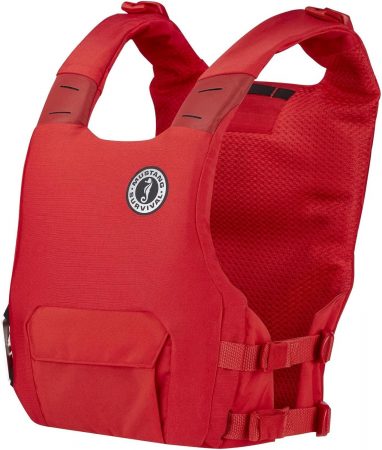
Life Jacket Style: Hybrid Foam/Inflatable Vest
USCG Classification: Type V
Measured Weight: 27.9 oz.
Claimed Buoyancy: 20.0 lbs. total (7.5 lbs. foam + 12.5 lbs. inflated)
Sizes Available: One Size (30″-52″ chest)
Pros: Comfortable low-profile design provides plenty of mobility, dual-flotation design means foam vest can be inflated for additional buoyancy
Cons: Expensive, foam vest alone provides minimal buoyancy
The Mustang Survival Khimera Dual Flotation PFD is a unique hybrid between a traditional foam life jacket and a modern inflatable vest style. The low-profile design is snug and comfortable, and stays put on your torso while paddling much better than most other bulky foam vests. The foam material provides some flotation (7.5 pounds) on its own, while pulling the ripcord to inflate the vest adds another 12.5 pounds. The 20 pounds of total buoyancy is more than many traditional foam vests.
The obvious advantage over most foam vests is that the lower-profile design provides the wearer much better mobility during dynamic activities like stand up paddle boarding, canoeing, kayaking, or recreational sailing. The snug, streamlined fit is very comfortable and unobtrusive.
In calmer conditions, the foam vest on its own provides enough buoyancy to comfortably assist you in getting back onto your paddle board or other vessel. And if needed during more windy or wavy situations, the added buoyancy from pulling the ripcord provides additional peace of mind. Note that users must have the presence of mind to pull the inflation ripcord to take advantage of its full buoyancy, so we would recommend this life jacket for experienced and confident paddlers and swimmers.
CHECK PRICE ON Mustang Survival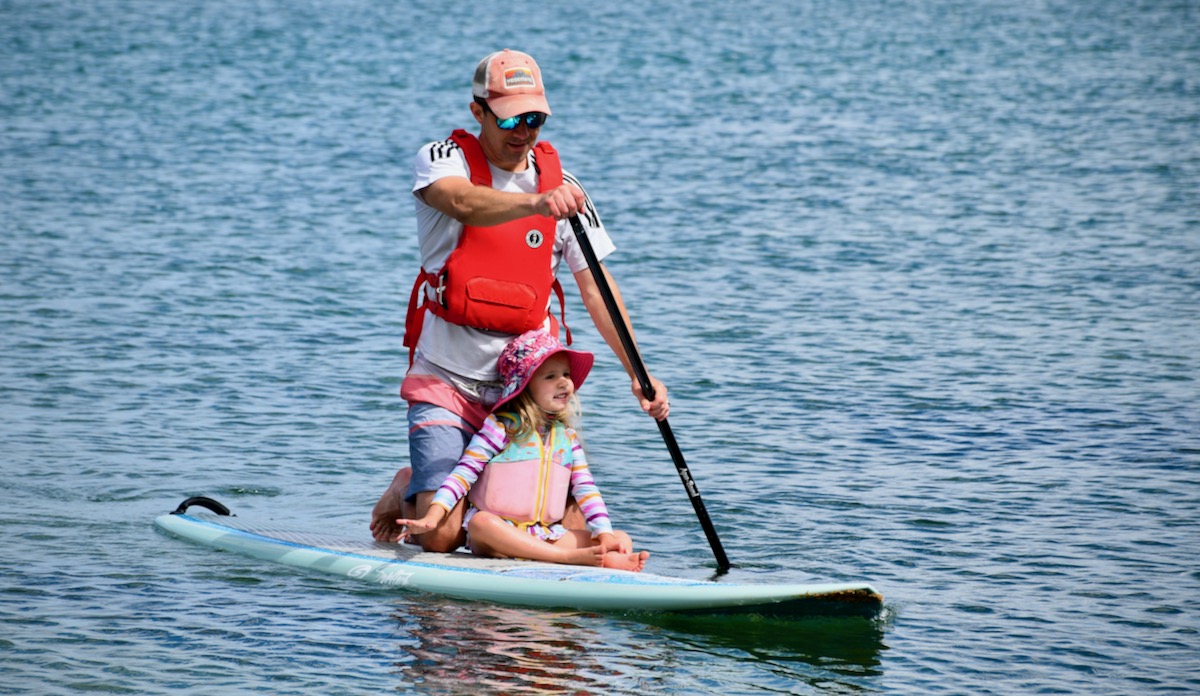
The Mustang Survival Khimera has a low-profile fit that provides top-notch comfort and mobility. Photo: Shannon Bruckbauer//The Inertia
More of our Favorite Life Jackets for Paddle Boarding
While the above top picks represent the best products on the market in their respective styles, we also tested several other capable life jackets that will help you stay safer (and legal) out on the water. Each of these models was personally tested in the field by our team.
Another Ultralight Inflatable Belt Style
Mustang Survival Minimalist Belt Pack ($100)
Life Jacket Style: Inflatable Belt
USCG Classification: Type V
Measured Weight: 12.5 oz.
Claimed Buoyancy: 15.7+ lbs.
Sizes Available: One Size (30″ to 52″ waist)
Pros: Super lightweight with a compact footprint
Cons: No extra pockets or features
The Mustang Survival Minimalist Belt Pack is one of the smallest and lightest inflatable belt packs that we tested. Tipping the scales at just 12.5 ounces, it is a mere one ounce heavier than the lightest life jacket in our test lineup (the Onyx M-16 at 11.4 ounces). Simple in design with no pockets or extra features, the Minimalist has one of the smallest and most compact footprints on the market.
The Minimalist is ideal for experienced paddlers who are strong swimmers and don’t necessarily want to wear a life jacket when paddling but recognize they need to follow paddling regulations and have something on hand in case of an emergency. Like its name, the Minimalist has a bare-bones design that almost makes you forget you’re wearing a life jacket at all. Because of this, it’s not as well suited for new paddlers or less confident swimmers who might need a bit more substantial flotation.
CHECK PRICE ON REI
The Mustang Survival Minimalist Belt Pack has one of the smallest footprints of any life jacket we tested. Photo: Shannon Bruckbauer//The Inertia
The Lightest Foam Vest We Tested
Astral YTV 2.0 ($150)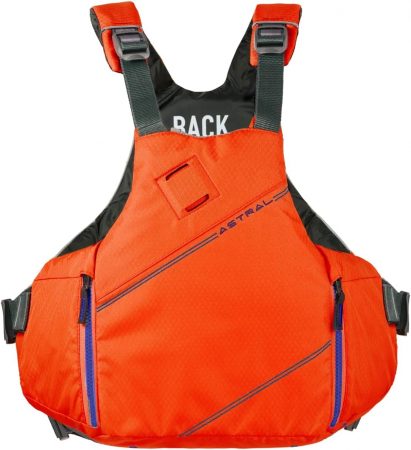
Life Jacket Style: Foam Vest
USCG Classification: Type V
Measured Weight: 19.8 oz.
Claimed Buoyancy: 16.5 lbs.
Sizes Available: S/M (31″-37″ chest), M/L (38″-44″ chest), L/XL (45″-51″ chest)
Pros: Lightweight, fairly streamlined fit, includes zippered storage pockets
Cons: Can sometimes ride up on the chest while paddling
The Astral YTV 2.0 is a modern foam vest that is optimized for dynamic activities thanks to its snug wrap-around fit and its lightweight design. Measured at 19.8 ounces on our home scale, the YTV 2.0 is the lightest foam vest life jacket that we tested. It has dual adjustment straps on both sides, adjustable padded shoulder straps, three total zippered storage pockets, and is available in four different colors.
Although the YTV 2.0 is designed for paddling and meant to stay put during dynamic movements, we still found it riding up over our rib cage and onto our chest while paddling. Because of this, we prefer the NRS Ninja as our favorite overall foam vest life jacket, even though it is quite a bit heavier than the YTV 2.0 (34.7 ounces vs. 19.8 ounces). Still, the YTV 2.0 is a great lightweight option and provides better mobility for paddle boarding than most other foam vests.
CHECK PRICE ON REI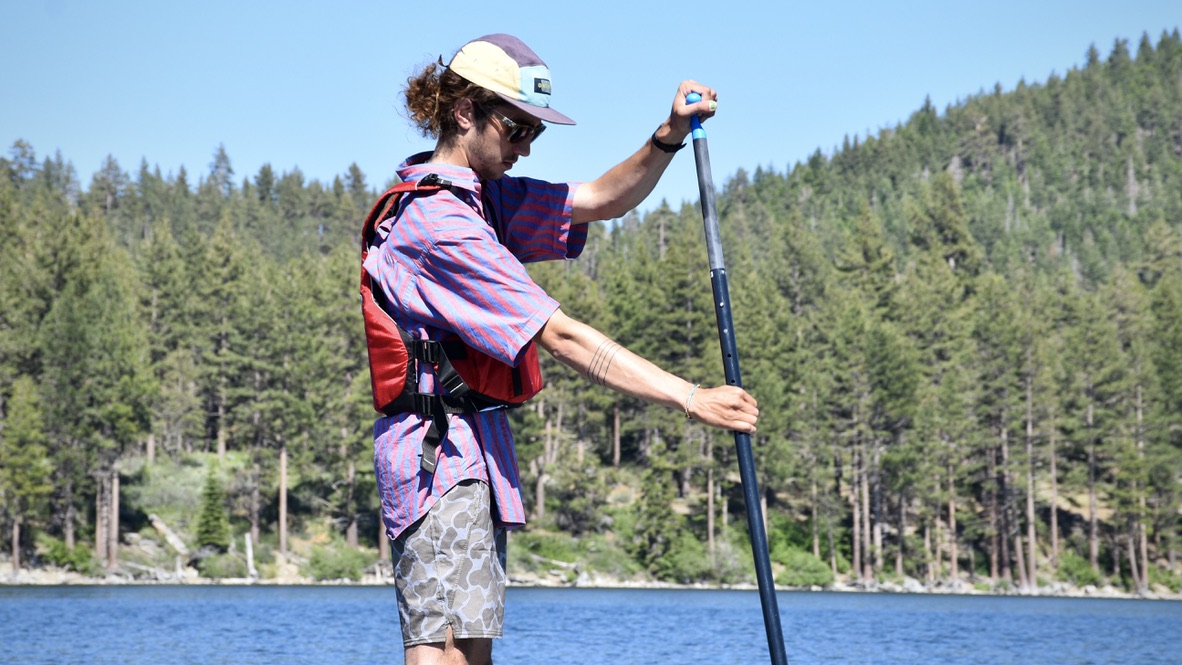
The Astral YTV 2.0 has a snug fit that wraps around the torso, but can still occasionally ride up onto the chest while paddling. Photo: Nick Bruckbauer//The Inertia
A Classic Zippered Foam Vest
Astral E-Ronny ($135)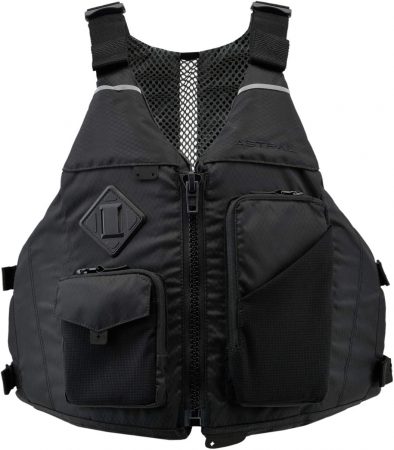
Life Jacket Style: Foam Vest
USCG Classification: Type III
Measured Weight: 24.5 oz.
Claimed Buoyancy: 16.0 lbs.
Sizes Available: S/M (31″-37″ chest), M/L (38″-44″ chest), L/XL (45″-51″ chest)
Pros: Lightweight, includes several pockets, decent comfort and mobility
Cons: Tends to ride up on the chest while stand up paddle boarding
Primarily designed for fishing and river paddling, the Astral E-Ronny is also a great option for stand up paddle boarding thanks to its comfortable, lightweight design. It has thinner material and a mesh vent on its back to make it more comfortable for sitting in a kayak or boat seat, but this also gives it a snug, comfortable fit while stand up paddling. At a respectable 24.5 ounces in the size Medium/Large that we tested, it is a great option for young or inexperienced paddlers who want the added security of a traditional foam vest.
The only drawback we found with the E-Ronny is that its streamlined fit could sometimes cause it to ride up on the chest during a dynamic activity like paddle boarding. While all foam vests may have this tendency, we didn’t experience that quite as much with the NRS Ninja. Still, the E-Ronny is a great choice for a foam vest and has added features like several front gear pockets and a front zippered entry.
CHECK PRICE ON Astral CHECK PRICE ON Amazon

The Astral E-Ronny has a snug, streamlined fit and a well-ventilated mesh back panel. Photo: Shannon Bruckbauer//The Inertia
A Pricier Inflatable Belt Pack
Astral Airbelt 2.0 ($135)
Life Jacket Style: Inflatable Belt
USCG Classification: Type V
Measured Weight: 13.1 oz.
Claimed Buoyancy: 22.5+ lbs.
Sizes Available: One Size (30″ to 52″ waist)
Pros: Lightweight, includes a storage pocket
Cons: The long, horizontal pack doesn’t hug the waist as well as smaller packs, pricey compared to similar designs
The Astral Airbelt 2.0 is a simple, lightweight inflatable belt life jacket. Weighing just 13.1 ounces, it’s among the lightest models that we tested and is the lightest product in our lineup that includes a zippered pocket.
While we appreciate the Airbelt’s lightweight design, we think the list price is a little high for such a simple product. If you’re willing to sacrifice the zippered pocket and add about 2.5 ounces to your belt, the BOTE Inflatable Belt PFD has a very similar design but retails for nearly $50 less. Also note that the long, horizontal pack design of both the Airbelt and the BOTE can be a little stiff and might not fit as snugly or feel as comfortable for paddlers with smaller waists.
Still, the Astral Airbelt is a quality product that will satisfy life jacket wearing requirements and could provide a decent value if found on sale.
CHECK PRICE ON ASTRAL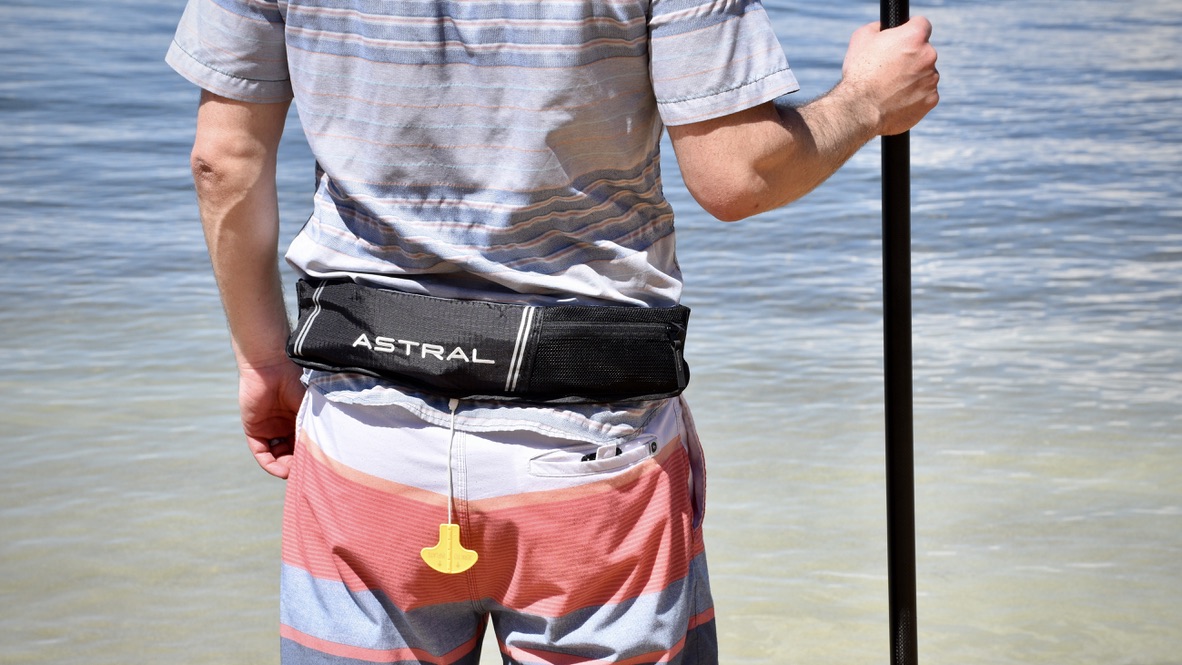
The Astral Airbelt 2.0 is a simple, lightweight inflatable belt, but the long, horizontal pack might not be as comfortable on smaller waists. Photo: Shannon Bruckbauer//The Inertia
Another Capable Inflatable Vest
Onyx A/M-24 Inflatable Vest ($220)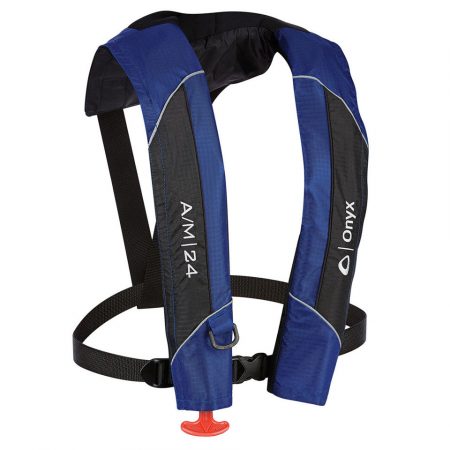
Life Jacket Style: Inflatable Vest
USCG Classification: Type V
Measured Weight: 20.5 oz.
Claimed Buoyancy: 22.5 lbs.
Sizes Available: One Size (30″ to 52″ chest)
Pros: Can be inflated automatically or manually, lightweight for a vest
Cons: Pricier than other similar inflatable vests (currently available on Amazon for much less than the list price)
The Onyx A/M-24 Inflatable Vest has the convenience of being able to be inflated in three different ways: automatically once it is submerged in water, manually by pulling the ripcord, or orally by using the oral tube. The vest is relatively lightweight at a measured 20.5 ounces and feels pretty minimalist while wearing it.
The A/M-24’s default setting is automatic, but the inflation mechanism can easily be switched out so that it only inflates manually. This may better suit more paddlers who don’t necessarily want or need the life jacket to inflate every time they enter the water.
While the A/M-24 is definitely a quality product, the BOTE Inflatable Vest PFD has nearly the same design, weight, specs, and inner components and has a list price of around $50 less. However, we’ve frequently found the A/M-24 on sale for much less.
Check out the video below to see how the A/M-24 inflates by pulling the ripcord.
CHECK PRICE ON AMAZONBest Life Jackets for Paddle Boarding Comparison Table
| Life Jacket | List Price | USCG Classification | Measured Weight | Claimed Buoyancy |
| Mustang Survival Essentialist Belt Pack | $150 | Type V | 13.8 oz. | 18.9 lbs. |
| BOTE Inflatable Belt PFD | $99 | Type V | 13.6 oz. | 22.5 lbs. |
| Onyx M-16 Inflatable Belt | $120 | Type V | 11.4 oz. | 22.5 lbs. |
| NRS Zephyr Inflatable PFD | $150 | Type V | 20.0 oz. | 27.8 lbs. |
| NRS Otto Matik Inflatable Vest | $215 | Type V | 23.0 oz. | 22.5 lbs. |
| BOTE Inflatable Vest PFD | $169 | Type V | 21.0 oz. | 26.0 lbs. |
| NRS Ninja PFD | $150 | Type III | 34.7 oz. | 15.8 lbs. |
| Mustang Survival Khimera Dual Flotation | $220 | Type V | 27.9 oz. | 20.0 lbs. total (7.5 lbs. foam + 12.5 lbs. inflated) |
| Mustang Survival Minimalist Belt Pack | $100 | Type V | 12.5 oz. | 15.7+ lbs. |
| Astral YTV 2.0 | $150 | Type V | 19.8 oz. | 16.5 lbs. |
| Astral E-Ronny PFD | $135 | Type III | 24.5 oz. | 16.0 lbs. |
| Astral Airbelt 2.0 | $135 | Type V | 13.1 oz. | 22.5 lbs |
| Onyx A/M-24 Inflatable Vest | $220 | Type V | 20.5 oz. | 22.5 lbs. |

Lead tester Nick Bruckbauer, maneuvering on board while wearing the NRS Ninja. Photo: Shannon Bruckbauer//The Inertia
How We Tested the Best Life Jackets for Paddle Boarding
While thawing from a historic Lake Tahoe winter in early 2023, we rigorously inspected each of these life jackets at home in anticipation of the spring paddling season. We thoroughly pored through the owner’s manuals and safety warnings to understand each product’s operation, weighed each product, tried each one on and tested straps, buckles, and adjustments, and properly armed each inflatable device with its included CO2 cartridge to prepare to hit the water.
Once spring finally came, we headed out to the lake to brave the chilly 50-degree water. We made sure each jacket was sized and fit properly and jumped on a board for a test paddle. We evaluated the fit and comfort of each jacket and how it felt while paddling, paying close attention to any restrictions on movement or mobility. We manually deployed the C02 cartridges of the inflatable devices and even took a dip in the frigid water to test the automatic inflation mechanisms. We continued testing these life jackets throughout the following summer paddling seasons, and updated this Guide in summer 2025 with two additional products.
Our testing team is led by Lake Tahoe resident Nick Bruckbauer. Nick grew up in the Midwest but got hooked on paddle boarding in the early 2010s while living in Santa Barbara, CA, and has tested nearly 30 different hard and inflatable paddle boards through the years, as well as several dozen of the best SUP paddles. After being reprimanded by the Coast Guard for not carrying a flotation device, he has been committed to wearing or carrying one each time he paddles and has made it his mission to find the lightest and most comfortable life jackets for all types of paddle boarders.
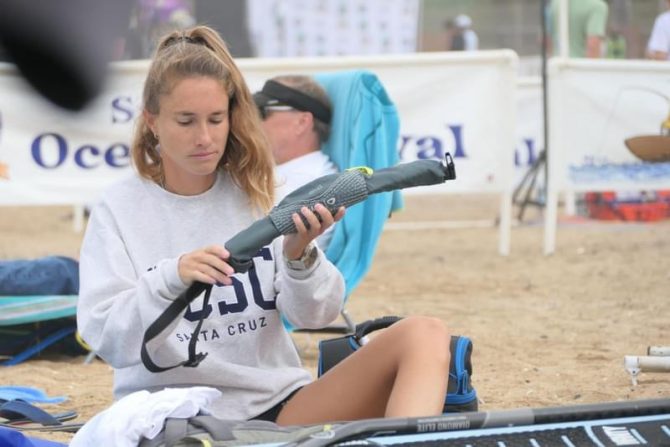
Double-checking your PFD before you paddle out is always a good idea. Photo: Stacey A//The Inertia
How to Choose the Best Life Jacket for Paddle Boarding
Life Jackets vs. PFDs
The terms life jacket and PFD (personal flotation device) often get thrown around interchangeably. The U.S. Coast Guard defines five different types of PFDs (more on that below) and defines a Type I PFD as an Off-Shore Life Jacket, which provides the most flotation out of any PFD. This means that by the official definition, only Type I PFDs are considered life jackets.
However, for casual boating and paddling — and in this Buyer’s Guide — the terms life jacket, life vest, and PFD are used interchangeably, and most people understand whichever term you use for any type of flotation device.
U.S. Coast Guard PFD Classifications
The U.S. Coast Guard defines five different types of PFDs based on their style, design, amount of flotation provided, and best-use scenarios.
Type I PFDs or Off-Shore Life Jackets are often bulky and somewhat restrictive, but provide the most flotation of any type of PFD. They are best suited for open, rough, or remote water where rescue may be slow, and are designed to turn the wearer face up in the water should they become unconscious.
Type II PFDs or Near-Shore Buoyant Vests are intended for general boating activities in calm, inland waters where there is a good chance for a fast rescue. They are typically less bulky than Type I PFDs, yet may still turn the wearer face-up in the water should they become unconscious.
Type III PFDs or Flotation Aids are typically used for general boating or dynamic activities like water skiing, fishing, canoeing, kayaking, or paddle boarding. They will be less bulky and more comfortable for continuous wear, but will not turn the wearer face up in the water.

The NRS Ninja is considered a Type III PFD. Photo: Shannon Bruckbauer//The Inertia
Type IV PFDs or Throwable Devices may be in the form of a seat cushion or a ring. These are convenient backup devices to wearable PFDs, but they have their limitations, as they are not suitable for children, non-swimmers, or someone who is unconscious.
Type V PFDs or Special Use Devices are specialized products suitable only for certain uses or conditions. These devices typically have specific use criteria to make them legal. For example, many Type V devices must be worn in order to be legal, whereas other types merely need to be carried on the boat or vessel. All of the inflatable devices in this buyer’s guide are Type V devices that must be worn at all times.

All of the inflatable devices in our test lineup, including the Mustang Survival Essentialist shown here, are considered Type V PFDs and must be worn at all times to be legal. Photo: Nick Bruckbauer//The Inertia
U.S. Coast Guard Regulations
The U.S. Coast Guard classifies stand up paddle boards (SUPs) as a vessel. This means that any time you paddle a SUP board outside of a surf zone or designated swim area, regulations for wearing or carrying a life jacket/flotation device will apply.
Generally, this means that children 12 years old or younger must wear an approved Type I, Type II, or Type III flotation device at all times. Paddlers 13 years or older must wear or carry a Type I, Type II, or Type III flotation device on board at all times or wear a Type V flotation device at all times.
An approved device must be in serviceable (working) condition and must be properly sized and fitted for the individual wearing it.

All of the inflatable belt and inflatable vest life jackets that we tested in this Buyer’s Guide are classified as Type V PFDs. Type V PFDs may only legally be worn by paddlers 16 years or older and must be worn at all times in order to be legal.
We strongly recommend that you review and follow all U.S. Coast Guard and local regulations any time you paddle, and be realistic about your experience level and swimming capabilities when deciding what type of life jacket or personal flotation device to wear or carry.
Inherently Buoyant (Foam) vs. Inflatable PFDs
Inherently buoyant PFDs are just that — naturally buoyant devices that don’t need any type of preparation, activation, or inflation in order to work. A traditional foam life jacket or life vest is a good example. The obvious advantage is that they are always ready to be used and therefore are suitable for more remote waters, for children, or for poor or non-swimmers. They are also typically more rugged than inflatable models and require very little maintenance or inspection. The disadvantage is that they are often heavier, bulkier, and more restrictive than inflatable devices.

The Astral E-Ronny is an example of an inherently buoyant life jacket. Photo: Shannon Bruckbauer//The Inertia
Inflatable PFDs must be activated and inflated in order to provide flotation. They might be activated automatically when a built-in sensor is submerged in water, manually by pulling on a ripcord to activate a pressurized air canister, or by orally inflating a built-in air tube. The advantage of inflatable devices is that they are usually much lighter and less bulky, while the obvious disadvantage is that they must be activated prior to use. This makes them poor choices for children, non-swimmers, or for situations where you might be knocked unconscious before being able to activate.

The Mustang Survival Essentialist is a Type V PFD that must be worn at all times and requires oral or manual inflation in order to provide buoyancy. Photo: Shannon Bruckbauer//The Inertia
In this Buyer’s Guide, we tested a few inherently buoyant (foam) devices that are classified as Type III PFDs, while the majority of the products are inflatable devices that are classified as Type V PFDs (that will provide Type III performance when properly inflated).
Which Design is Right for You?
First of all, we again recommend checking your local regulations. Some jurisdictions may have special requirements for children, for example, or may have different requirements depending on the type of water or location in which you’re paddling.
Next, you should consider your paddling and swimming abilities and your paddling environment. Depending on your experience and comfort level, it may make more sense to have the extra security of a foam life jacket or the lightweight and freedom of an inflatable model.
Considerations
Are you an experienced paddler who rarely falls or a beginner who will likely make some splashes? Are you a strong swimmer who can quickly and comfortably react to different situations in the water or a less confident swimmer? Are you going to be paddling in warmer, calmer water or in cold, rough water? Are you in a familiar environment or a new location? Are you alone and far from shore, or are you near shore with lots of people around?
Recommendations
For paddle boarding, we would generally recommend a Type III inherently buoyant (foam) device for children, for poor or non-swimmers, or for paddlers venturing into especially rough or cold water where extra security is needed. Wearing a Type III device will provide flotation without any activation or inflation, will likely keep you a little warmer than an inflatable device, and may provide some padding should you fall and bump into your board. The disadvantage to Type III foam devices is that they’re typically heavier and bulkier and could impact your range of motion and comfort while paddling. Our favorite Type III device is the NRS Ninja.

The NRS Ninja is our favorite Type III (foam) life jacket for paddle boarding. Photo: Shannon Bruckbauer//The Inertia
For experienced adult paddlers who are strong and confident swimmers and are paddling in calm water — or are familiar and comfortable with their paddling surroundings — we would recommend a Type V inflatable device. These devices come in vest and belt configurations. The clear advantage is that wearing one of these inflatable devices meets U.S. Coast Guard requirements while providing a much lighter, freer, less encumbered paddling experience. This is ideal for paddlers looking to go fast and light and focus on performance.

The Onyx M-16 is the lightest inflatable belt (Type V) device that we tested, at only 11.4 ounces. Photo: Shannon Bruckbauer//The Inertia
Keep in mind that with most inflatable devices, you must manually pull a ripcord in order to inflate it, so they make not be appropriate if you are paddling far from shore, in unfamiliar waters, or if you’re not confident in your ability to react and inflate the vest should you fall in the water. It is also critical to make sure inflatable devices are regularly inspected and maintained to ensure they are properly armed and in good working condition before use.
Some Type V inflatable models, like the NRS Otto Matik vest, provide the best of both worlds. This vest is much lighter than most foam life jackets and will automatically inflate once the built-in sensor is submerged in water.

The NRS Otto Matik automatically inflates once submerged in water, providing extra protection in case you take a spill like this! Photo: Shannon Bruckbauer//The Inertia
Note: If you are paddling alone, far from shore, and in extreme conditions where you could potentially be knocked unconscious, we recommend wearing a Type I or Type II PFD that will likely be able to keep you face-up in the water in an emergency situation.
Inflatable Devices
How do Inflatable Devices Work?
Inflatable life jackets or PFDs can typically be inflated in a few different ways:
Manually: All of the inflatable devices we tested can be inflated by pulling or “jerking” on a ripcord that activates a pressurized CO2 cylinder that is armed inside the life jacket. Pulling this cord will puncture the CO2 cylinder and inflate the life jacket within about 5 to 10 seconds. Keep in mind that you will need to have the situational awareness to pull this cord when you’re potentially in or falling into the water, so it may be a good idea to practice this ahead of time.
Orally: Every inflatable device we tested can also be fully inflated or “topped off” orally with a built-in air tube. These tubes have a simple one-way valve that allows you to orally inflate the life jacket in a handful of breaths should the built-in CO2 cylinder fail for some reason. This allows you to “top off” the life jacket with a little extra air to improve flotation if the CO2 cylinder doesn’t fill it to your desired inflation.

Inflating the BOTE Inflatable Vest with the oral inflation tube. Photo: Shannon Bruckbauer//The Inertia
Automatically: A few models we tested (the BOTE Inflatable Vest and the Onyx A/M-24) are considered Automatic/Manual devices. These life jackets have a built-in sensor adjacent to the CO2 cylinder that will automatically activate inflation once it is submerged in water for a few seconds. This can be especially helpful if you’re not confident in your ability to manually pull a ripcord in the heat of the moment. These models can also be activated manually by pulling the ripcord or orally through the built-in inflation tube.
Re-Arming
Each time you manually or automatically inflate a life jacket using the built-in CO2 cartridge, you must re-arm and prepare your life jacket before the next use. You will also need to deflate the inflatable part of the life jacket and re-pack it back into its housing.
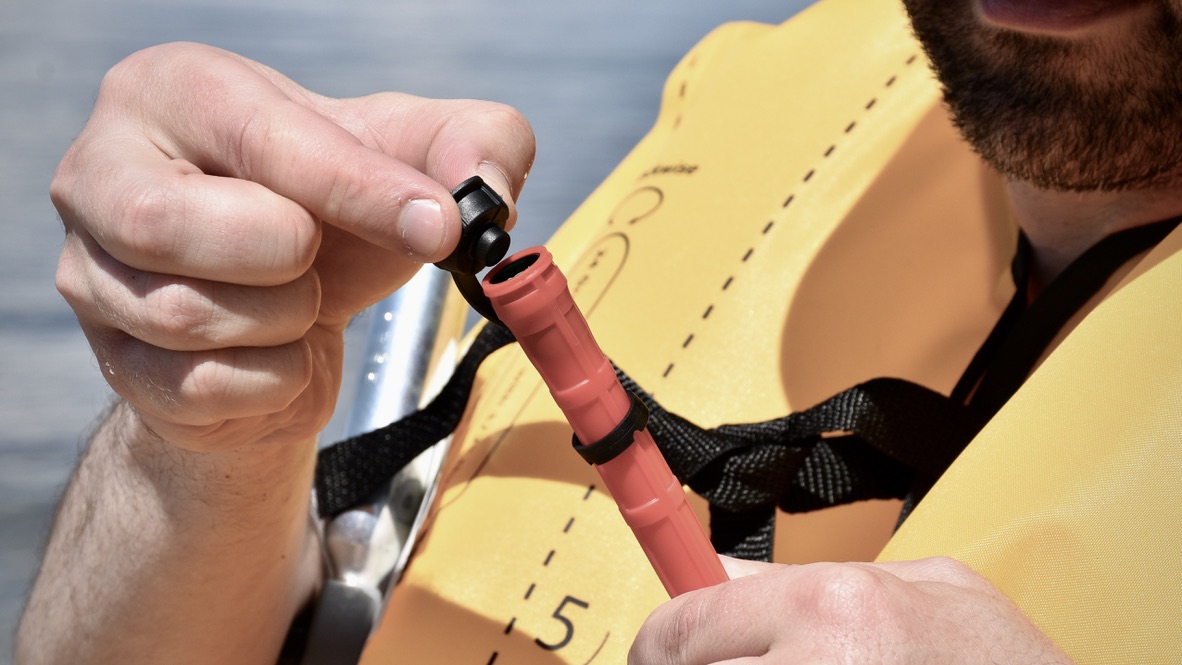
Deflating the NRS Zephyr by inserting the opposite end of the oral tube cap into the tube to release the air valve. Photo: Shannon Bruckbauer//The Inertia
Each time you pull the ripcord to inflate your life jacket, you will break a green “indicator tab” (that is intended as a visual indicator that the life jacket is armed and ready to use), and you will expend the CO2 cartridge. Both of these must be replaced in order to re-arm the life jacket for the next use.
Most models have a specific re-arming kit (sold separately) that includes the proper CO2 cartridge and a new green “indicator tab.” Each product also specifies the cartridge size and thread size, so you could theoretically re-arm it with any suitable CO2 cartridge if you’re comfortable going without a new “indicator tab.”
Inflatable Device Inspection & Maintenance
Most inflatable devices recommend a regular inspection protocol at the start of each paddling season and at least every two months during the paddling season. Because there are more technical parts involved in an inflatable model, this is critical to ensure that they are functioning properly.
Most manufacturers recommend checking the oral valve, inflating the life jacket to check for leaks, inspecting the CO2 cylinder to ensure it is properly armed, and inspecting the outer shell fabric and any webbing, straps, buckles, or attachments.
Each product comes with thorough documentation that includes a user manual, safety instructions, and plenty of warnings, so be sure to read through all of these materials to understand how to use and maintain your life jacket properly.
Life Jacket Sizing and Fit
It is important to make sure that your life jacket is properly sized to fit your age, size, and body type. Most Type I, Type II, and Type III foam PFDs come in a range of sizes to fit infants, children, youth, and adults. Make sure to read the manufacturer’s sizing guidelines to see which size fits you best.
Type V inflatable life jackets typically come in only one size and are only intended for adults — typically paddlers 16 years and older and 80 pounds and greater. This applies to all of the inflatable belt and inflatable vest models in this Buyer’s Guide.
Comfort and Mobility
Stand up paddle boarding is such a dynamic sport that your comfort and mobility are important considerations in finding the right life jacket for you.
Beginners, casual paddlers, or less confident swimmers will likely prefer the added safety, potential added warmth, and “always ready” convenience of a Type III foam life jacket and will probably be willing to live with the slight added bulk and potentially reduced mobility. Keep in mind, though, that today’s best foam life jackets are lighter, sleeker, and better-fitting than ever before.
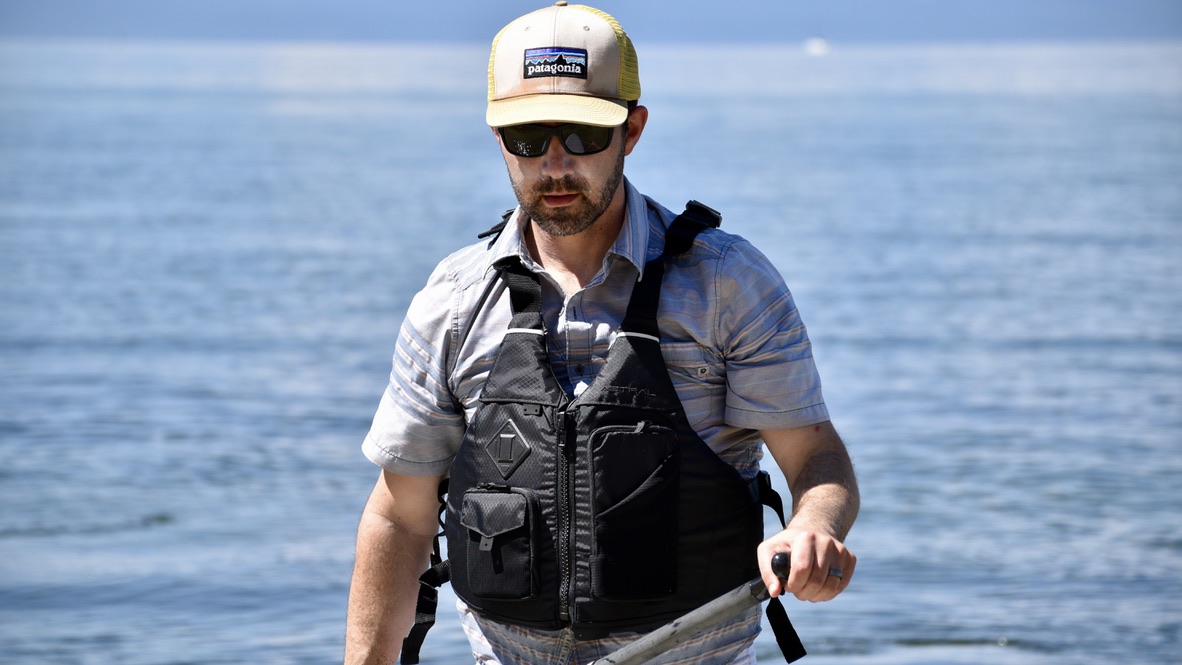
Type III life jackets, like Astral E-Ronny, are a little bulkier and heavier than inflatable devices but still offer a comfortable and streamlined fit. Photo: Shannon Bruckbauer//The Inertia
Experienced paddlers and strong swimmers who prioritize comfort, mobility, and performance will appreciate the free and unencumbered feeling of a Type V inflatable life jacket. Paddling with a sub-1-pound belt around your waist has a very little noticeable impact on your movement and comfort, yet still meets Coast Guard requirements and provides a factor of safety should you need it. Performance-oriented paddlers who scrutinize the best paddle boards or the best SUP paddles will appreciate the lightweight performance of a Type V inflatable belt to complete their performance kit.
Return To: Top Picks | Comparison Table | How We Tested | Buyer’s Guide
Related: Best Paddle Boards | Best Inflatable Paddle Boards | More Paddle Gear Reviews
Editor’s Note: For more gear reviews and features on The Inertia, click here.

